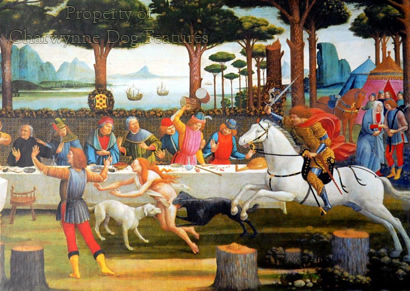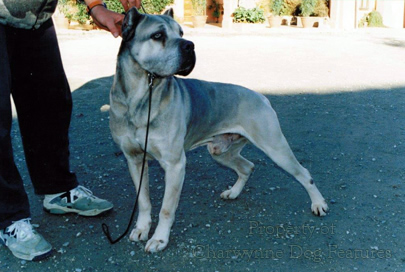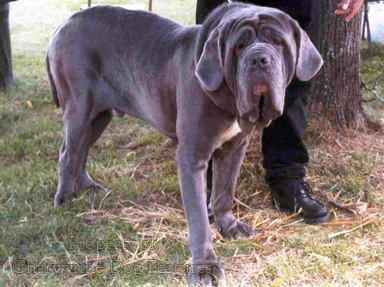764 ITALIAN SEIZERS
THE ITALIAN ‘SEIZERS’
by David Hancock
 Breed Differences
Breed Differences
The two mastiff breeds of Italy, the Neapolitan and the Cane Corso undoubtedly share a recent common origin and when the latter is bred to the heavier design can be confused even when side by side. In summary, the Neapolitan is looser-skinned, more heavily wrinkled, especially around the head and neck, is taller and heavier and has the larger skull. I recently read an expensive Italian book on the Neapolitan where it described the Cane Corso as coming from Corsica. (The book also contained a number of photographs of ancient statues of the big cat family, claimed as mastiff dog portrayals, so desperate was the author to promote his breed). Piero Scanziani, a respected breeder and writer of the 1950s, however, linked the word 'Corso' not with Corsica but an old Italian word for robust or strong; I would be inclined to link this word with the Latin 'coercere', to restrain or hold back, for that is what all the holding dogs do. Scanziani considered this breed title another name for the Neapolitan Mastiff. But now, probably correctly, we have two quite separate breeds, recognised as such by the FCI.
White Mastini
I believe that in southern Italy there still can be found fanciers who prefer shorter-legged Neapolitans, similar to the low-slung mastini of Zaccaro, a type associated with Naples half a century ago. About that time, in Campania, near Lake Patria, Claudio Cocchia maintained a kennel of white mastini. This was more the 'dirty' white found for example in the Soft-coated Wheaten Terrier, than the pure white of, say, the Bull Terrier. But white does feature in the modified brachycephalic breeds, as the Bulldog and the Boxer can demonstrate. Its association with albinism and deafness leads to its exclusion in more than one breed however.
 Gripping or Holding Breeds
Gripping or Holding Breeds
The Neapolitan Mastiff (although some claim this was the Cane Corso type) has been called the 'cane de presa', or gripping dog, in Naples, just as the Spanish sister breeds are called Perro de Presa Canario and Perro de Presa Mallorquin and the Portuguese and Brazilian related breeds Fila de Sao Miguel and Fila Brasileiro respectively. Presa or Fila means seizing and holding and refers to the same characteristic as found in the 'beissers' further north. The dogs used to hold or grip there were called barenbeissers, for use on bears, bullenbeissers, for use on bulls and bufalbeissers when used on buffalo or bison. This group of dogs was immensely valuable to man in the hunting field before the development of firearms. Cattlemen still use them in the Azores and South America, with North American ranchers also trying them.
Breed Points
It is vital, now that the Cane Corso and the Neapolitan Mastiff have been recognised as distinct breeds, for each of them to retain their own special breed points. There is a theory that once breeders preferred the heavier and much more wrinkled variety now known as the Neapolitan, then the lighter tighter skinned dogs were given to farmers in the neighbourhood as stock dogs. This latter type was utilised by butchers. In Sicily, a type called the Branchiero was favoured and developed a slightly different phenotype, just as the flock protector the Cane di Manerra developed as a variation of the Abruzzi sheepdog.
Varieties
The Abruzzi sheepdog, a bigger fiercer version of the Maremma sheepdog, has been crossed with the Cane Corso to produce the 'Mezzocorso', a more abrasive flock protection dog. Similarly, the 'Mezzosangue' is a mix of Cane Corso and scent hound to improve tracking qualities and the 'Mezzolevriero' a blend of Cane Corso and sighthound to improve speed. (The 'boar-lurcher' of central Europe and the alaunt veltreres referred to by De Foix each consisted of this mix.) The 'Vuccerisco' of Sicily was of this type and is being restored, as is a Cane Corso variety in Calabria called the 'Bucciriscu'. Sardinia possesses another variety called the Dogo Sardo, a cattle dog, usually brindle and not seen outside that island. The fanciers of the Cane Corso claim that it is their breed that is 'the true hunting mastiff' of Italy.
 More Mobile
More Mobile
The Cane Corso has a short dense coat in a range of colours: black, mahogany, chestnut, fawn, blue or these colours brindled. Its tail is docked to one-third of its length. Strongly boned and well muscled, the breed looks more mobile than its sister breed, the Neapolitan Mastiff. Even with a minimum height of 24" and a minimum weight of 100lbs, the Cane Corso is smaller than the Neapolitan but sensibly, whilst size is valued, it is firmly stated not to be at the expense of activity or movement. I understand that in southern Italian dialect, mainly the Puglia region, 'Corso' still means strong in the sense of robust.
Fear of Exaggeration
Both these Italian mastiff breeds are proving popular abroad but I do hope that the distinctive Neapolitan doesn't become more exaggerated as foreign fanciers express their whims. This breed comes from a tiny modern gene pool, most stock being derived from two dogs of unknown breeding fifty years ago. It is a highly individual breed, with its own style of physique and temperament. The breed displays great forward extension and has remarkable elasticity of skin. The puppies are particularly loose limbed. Despite their abundant wrinkle the eyes are never blinded, unlike some Bloodhounds. The double dewlap is a breed feature. I understand that the Italians prize the fold going vertically from the lower ear to the angle of the jaw.
 Harmful Gait
Harmful Gait
There is no sign of any abundance of loose skin in the bas-reliefs of the Assyrian hunting mastiffs, from which Neapolitan Mastiff fanciers claim their breed is descended. I am forever suspicious too when an idiosyncratic gait is claimed for a breed. Such a claim is never made for the sister mastiff breeds and a rolling gait is undesired in just about every other breed. When there is imbalance between front and rear movement, the strain on the skeleton is greater. When this imbalance is compounded by substantial weight then the strain can be harmful to the bones, the hips especially, of any four-legged animal. A 'rolling' gait may be distinctive but it may also be harmful, and increasingly so as the dog gets older. I suspect that the higher croup too is an undesired feature which is only claimed to be a breed point when breeders are unable to breed it out.
Health Watch
Show ring judges have been asked by the Kennel Club to look out for harmful exaggerations, so often claimed as breed points, in the commendable drive for a sounder pedigree dog. Sadly, in the last half-century, the appearance of the Neo has been altered on human whim, with the pursuit of massive size, thickened bone, looser and looser skin, huge heads, a low-slung torso and a gait unconnected to any function. This can only result in deformed dogs and the unexaggerated Cane Corso may well end up as the principal representative of Italian mastiff breeds. The Cani Corso brought into Britain seem to fall into two quite different types: one, like a reduced form of the Neo, the other, a more athletic unexaggerated strong-headed cattle-dog from the rural areas where they are still used as such. No doubt those seeking massive ‘status dogs’ will flock to the Neo type and that would be a pity. There is much for the fanciers of these two Italian breeds to give thought to; the loss of either would be a shame, they are part of Italy’s canine heritage and deserve honest devoted patronage.